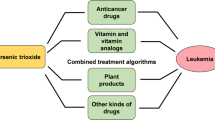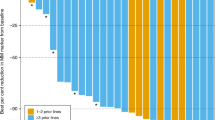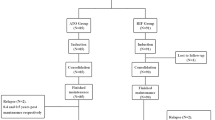Abstract
We previously showed that arsenic trioxide (ATO) and melarsoprol may inhibit the growth of multiple myeloma (MM) cells in vitro and in vivo. We report here the administration of arsenic derivatives in 12 relapsing or refractory secretory MM patients. A total of 10 patients received ATO (eight in a continuous schedule, two discontinuously) and two received melarsoprol. The melarsoprol arm was prematurely closed due to toxicity. In the ATO arm, median duration of treatment was 38 days (9–54). Hepatic toxicity was grade 3 and 2 in one and eight patients, respectively. Other toxicities included neuropathy (n=2, grade 2), encephalitis (n=1, grade 3) and leuconeutropenia (n=4, grade 3). At 2 weeks after treatment initiation, mean serum concentration of arsenic was 1.11±0.16 μmol/l. No complete or partial remission was observed. A minor response (25–49% reduction of M protein in serum) and a stabilization of the M-protein level were observed in three and four patients, respectively. After ATO discontinuation, these responses were of short duration in all cases. ATO as a single agent did not produce any significant response in advanced MM patients despite sufficient arsenic exposure. Strategies to improve biodistribution, pharmacokinetic and efficacy of the drug as well as treatment combinations are needed.
This is a preview of subscription content, access via your institution
Access options
Subscribe to this journal
Receive 12 print issues and online access
$259.00 per year
only $21.58 per issue
Buy this article
- Purchase on Springer Link
- Instant access to full article PDF
Prices may be subject to local taxes which are calculated during checkout

Similar content being viewed by others
References
Sun HD, Ma L, Hu XC . Ai-Lin 1 treated 32 cases of acute promyelocytic leukemia. Chin J Integr Chin West Med 1992; 1: 170–171.
Shen ZX, Chen GQ, Ni JH, Li XS, Xiong SM, Qiu QY et al. Use of arsenic trioxide (As2O3) in the treatment of acute promyelocytic leukemia (APL): II. Clinical efficacy and pharmacokinetics in relapsed patients. Blood 1997; 89: 3354–3360.
Soignet SL, Maslak P, Wang ZG, Jhanwar S, Calleja E, Dardashti LJ et al. Complete remission after treatment of acute promyelocytic leukemia with arsenic trioxide. N Engl J Med 1998; 339: 1341–1348.
Raffoux E, Rousselot P, Poupon J, Daniel MT, Cassinat B, Delarue R et al. Combined treatment with arsenic trioxide and all-trans retinoic acid in patients with relapsed acute promyelocytic leukemia. J Clin Oncol 2003; 21: 2326–2334.
Drach J, Kaufmann H, Urbauer E, Schreiber S, Ackermann J, Huber H . The biology of multiple myeloma. J Cancer Res Clin Oncol 2000; 126: 441–447.
Rousselot P, Labaume S, Marolleau JP, Larghero J, Noguera MH, Brouet JC et al. Arsenic trioxide and melarsoprol induce apoptosis in plasma cell lines and plasma cells from myeloma patients. Cancer Res 1999; 59: 1041–1048.
Park WH, Seol JG, Kim ES, Hyun JM, Jung CW, Lee CC et al. Arsenic trioxide-mediated growth inhibition in MC/CAR myeloma cells via cell cycle arrest in association with induction of cyclin-dependant kinase inhibitor, p21, and apoptosis. Cancer Res 2000; 60: 3065–3071.
Hayashi T, Hideshima T, Akiyama M, Richardson P, Schlossman RL, Chauhan D et al. Arsenic trioxide inhibits growth of human multiple myeloma cells in the bone marrow microenvironment. Mol Cancer Ther 2002; 1: 851–860.
Liu Q, Hilsenbeck S, Gazitt Y . Arsenic trioxide-induced apoptosis in myeloma cells: p53-dependant G1 G2/M cell cycle arrest, activation of caspase-8 or caspase-9, and synergy with APO2/TRAIL. Blood 2003; 101: 4078–4087.
Rousselot P, Larghero J, Labaume S, Chopin M, Dosquet C, Marolleau JP et al. Arsenic trioxide is effective in the treatment of multiple myeloma in SCID mice. Eur J Haematol 2004; 72: 166–171.
Burri C, Nkunku S, Merolle A, Smith T, Blum J, Brun R . Efficacy of new, concise schedule for melarsoprol in treatment of sleeping sickness caused by Trypanosoma brucei gambiense: a randomised trial. Lancet 2000; 355: 1419–1425.
Munshi NC, Tricot G, Desikan R, Badros A, Zangari M, Toor A et al. Clinical activity of arsenic trioxide for the treatment of multiple myeloma. Leukemia 2002; 16: 1835–1837.
Hussein MA, Mason J, Saleh NM, Rifkin RM, Ravandi F . Arsenic trioxide (Trisenox) in patients with relapsed or refractory multiple myeloma (MM): final report of a phase II clinical study. Blood 2002; 100: 5138a.
Richardson PG, Barlogie B, Berenson J, Singhal S, Jagannath S, Irwin D et al. A phase 2 study of bortezomib in relapsed, refractory myeloma. N Engl J Med 2003; 348: 2609–2617.
Richardson PG, Schlossman RL, Weller E, Hideshima T, Mitsiades C, Davies F et al. Immunomodulatory drug CC-5013 overcomes drug resistance and is well tolerated in patients with relapsed multiple myeloma. Blood 2002; 100: 3063–3067.
Grad JM, Bahlis NJ, Reis I, Oshiro MM, Dalton WS, Boise LH . Ascorbic acid enhances arsenic trioxide-induced cytotoxicity in multiple myeloma cells. Blood 2001; 98: 805–813.
Borad M, Swift RA, Sadler K, Yang H, Berenson JR . Melphalan, arsenic trioxide and ascorbic acid (MAC) is effective in the treatment of refractory and relapsed multiple myeloma (MM). Blood 2003; 102: 827a.
Birch R, Schwartzberg LS, Lawrence V, Schnell FM, Tongol JM, Prill SJ et al. A phase II study of arsenic trioxide (ATO) in combination with dexamethasone (Dex) and ascorbic acid (VITC) in patients with relapsed/refractory multiple myeloma. Blood 2003; 102: 5271a.
Bahlis NJ, McCafferty-Grad J, Jordan-McMurry I, Neil J, Reis I, Kharfan-Dabaja M et al. Feasibility and correlates of arsenic trioxide combined with ascorbic acid-mediated depletion of intracellular glutathione for the treatment of relapsed/refractory multiple myeloma. Clin Cancer Res 2002; 8: 3658–3668.
Acknowledgements
This study was supported by Grant no. P970708 and AOM 97088 from Le Programme Hospitalier de Recherche Clinique, Ministère de l'Emploi et de la Solidarité, France.
Author information
Authors and Affiliations
Corresponding author
Rights and permissions
About this article
Cite this article
Rousselot, P., Larghero, J., Arnulf, B. et al. A clinical and pharmacological study of arsenic trioxide in advanced multiple myeloma patients. Leukemia 18, 1518–1521 (2004). https://doi.org/10.1038/sj.leu.2403424
Received:
Accepted:
Published:
Issue Date:
DOI: https://doi.org/10.1038/sj.leu.2403424
Keywords
This article is cited by
-
Arsenic trioxide: applications, mechanisms of action, toxicity and rescue strategies to date
Archives of Pharmacal Research (2024)
-
In vitro and ex vivo anti-myeloma effects of nanocomposite As4S4/ZnS/Fe3O4
Scientific Reports (2022)
-
A phase 1 trial of 4-(N-(S-penicillaminylacetyl)amino)-phenylarsonous acid (PENAO) in patients with advanced solid tumours
Cancer Chemotherapy and Pharmacology (2021)
-
Role of cysteine 288 in nucleophosmin cytoplasmic mutations: sensitization to toxicity induced by arsenic trioxide and bortezomib
Leukemia (2013)
-
Speciation of arsenic trioxide metabolites in blood cells and plasma of a patient with acute promyelocytic leukemia
Analytical and Bioanalytical Chemistry (2009)



